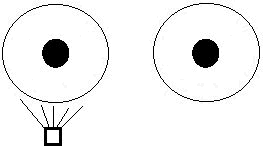- anisocoria ( the most cases being Horner's, Adie's, third nerve palsy.
- heterochromia (congenital Horner's syndrome and siderosis bulbi)
- ptosis (Horner's syndrome and third nerve palsy )
- RAPD (this indicate optic nerve disease or extensive retinal dysfunction.
- Horner's syndrome (neck or chest scar )
- Third nerve (ocular motility )
- Adie's pupil (slit-lamp for vermiform iris movement and knee jerk )
- Argyll-Robertson's pupil ( interstitial keratitis, deafness )
| 1. Observe:
Less commonly siderosis bulbi and traumatic. Although physiological anisocoria is the most common cause, it seldoms appear in the examination.) 3. Reaction to direct and consensual light. 4. Swinging light test for afferent pupillary defects. 5. Reaction to accommodation 6. Additional examination depends on the above findings
Look for optic disc pallor, advanced glaucoma cupping or total retinal detachment.)
In the presence of anisocoria, you are likely to be asked about differential diagnosis and the pharmacological diagnosis of anisocoria. Always have a list of causes for abnormal small or large pupil and learn the pharmacological diagnosis for Horner's syndrome and Adie's pupil well. |
||
a
|
||
| Back to the index for final MRCOphth |

